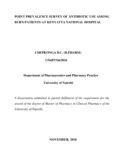| dc.contributor.author | Chepkonga, B C | |
| dc.date.accessioned | 2019-01-29T12:26:10Z | |
| dc.date.available | 2019-01-29T12:26:10Z | |
| dc.date.issued | 2018 | |
| dc.identifier.uri | http://hdl.handle.net/11295/105877 | |
| dc.description.abstract | Background: Burns are a global public health problem (ranked fourth of all injuries), accounting
for an estimated 180,000 deaths annually. Infection is common in burns and can delay wound
healing and encourage scarring. Infection remains the leading cause of death in people with a
burn wound and can independently cause death. Antibiotics can be used prophylactically or to
treat confirmed burn wound infections. Antibiotics are the most prescribed drugs globally but
most of their use is irrational. This causes the emergence of resistance and poor treatment
outcomes. There is scarce local data on patterns of antibiotic prescribing in Kenya and
specifically among burn patients, thus the impetus for the study.
Study Objective: To assess the antibiotic prescribing patterns among burn patients admitted to
the Kenyatta National Hospital (KNH).
Methods: This was a cross-sectional study involving burn inpatients admitted at KNH. A total of
68 participants were recruited through universal sampling and patient files that met inclusion
criteria selected. Data was abstracted from patient medical records. The data included sociodemographic
characteristics of the patients and the cause and type of burn. The indication, name,
dose, route of administration, duration and frequency of antibiotic were also noted. The raw data
was coded and entered into Microsoft Excel version 2010 to create a database, then exported to
STATA version 13 for analysis. Data was presented in frequency tables and charts. Associations
between predictor variables and outcome variables were determined using Fisher’s exact.
Logistic regression was done to determine the independent predictors of various causes of burns.
Statistical significance was set at 95% confidence interval and values with p≤0.05 were
considered statistically significant.
Results: The major cause of burns at KNH was open fire (48.5%) followed by scald burns
(32.4%). Scald burns were predominant in children under five. Electricity and chemical burns
constituted 13.2% and 5.9% of the burns respectively. Majority of the patients sustained 2nd
degree (83.8%) and 3rd degree (41.2 %) burns and many of the patients had mixed burns. The
percentage of total burnt subsurface area (% TBSA) ranged from a minimum of 3% to a
maximum of 65% with a mean TBSA of 21.4%. Participants aged ≥13 years had 7 times the
likelihood of having electricity or chemical burns (COR=7.0; 95% CI 1.44-35.12 p=0.016). The
prevalence of antibiotic use among burn patients at KNH was 91.2%. Topical antibiotics (69.1%)
followed by cephalosporins were the most prescribed antibiotics. Penicillins (30.9%) were third
most prescribed class. The antibiotics were mainly used for prophylaxis (67.6%) of burn wound
infections. Silver sulfadiazine (69.1%) was the most prescribed antibiotic while cefuroxime
(41.2%) was the most prescribed cephalosporin followed closely by ceftriaxone (38.2%).
Amoxicillin clavulanate (25.2%) was the most prescribed penicillin. There was 59.9% rational
prescribing of antibiotics among burn patients at KNH.
Conclusion: There was high prevalence of antibiotic prescribing among burn patients at KNH
and average rational use of antibiotics in compliance to local and international antimicrobial use
guidelines
Recommendation: There is need to lower the prevalence of antibiotic prescribing among burn
patients because recent guidelines do not advocate their use due to lack of evidence to prove that
they are efficacious and they can induce resistance. A KNH burn anti-bio-gram should also be
developed based on antibiotic susceptibility and resistance profiles in the burns unit | en_US |
| dc.language.iso | en | en_US |
| dc.publisher | University of Nairobi | en_US |
| dc.rights | Attribution-NonCommercial-NoDerivs 3.0 United States | * |
| dc.rights.uri | http://creativecommons.org/licenses/by-nc-nd/3.0/us/ | * |
| dc.title | Point Prevalence Survey of Antibiotic Use Among Burn Patients at Kenyatta National Hospital | en_US |
| dc.type | Thesis | en_US |
| dc.description.department | a
Department of Psychiatry, University of Nairobi, ; bDepartment of Mental Health, School of Medicine,
Moi University, Eldoret, Kenya | |



